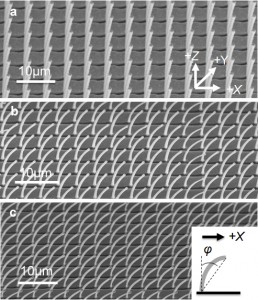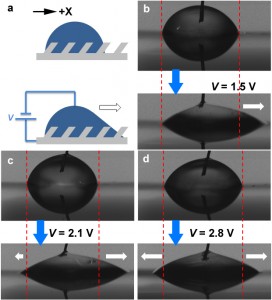Manipulation of Liquid Spreading on Asymmetric Nanostructured Surfaces
The manipulation of liquid spreading is important for a broad range of microfluidic, biological, and thermal management applications [1] [2] [3]. In this work, we investigated the ability to manipulate droplet spreading to a single direction on-demand on asymmetric nanostructured surfaces using electrowetting. Asymmetric nanopillar arrays were fabricated with diameters of 500 to 750 nm and deflection angles of 3 to 52 degrees. Figure 1 shows scanning electron micrographs (SEMs) of three representative asymmetric nanopillar arrays with deflection angles, φ, (as defined in the Figure 1 inset) ranging from 7°-25°. A Cartesian coordinate system is defined for convenience, as shown in Figure 1, where the pillars deflect in the positive X (+X) direction. In the presence of asymmetric nanostructures, the spreading behavior can be dynamically controlled with electrowetting, which utilizes an electric potential, V, across the droplet and nanostructured surface to change the surface energy (Figure 2a). With this approach, different droplet-spreading directionalities can be achieved based on the magnitude of the electric potential. If we apply V= 1.5 V to an initially static symmetric droplet, the liquid pins in the –X direction and spreads in +X, i.e. uni-directionally (Figure 2b). In the case of an applied V= 2.1 V, the liquid unpins in –X and spreads bi-directionally. The spreading, however, is asymmetric: the rate is three times faster in +X as compared to –X (Figure 2c). Moreover, with increasing applied V, the asymmetry decreases. In the case of an applied V> 2.5V, the liquid spreading is nearly symmetric, i.e. the rates in +X and –X are approximately equal (Figure 2d). The study provides design guidelines to tune the droplet’s behavior from uni-directional to asymmetric or symmetric bi-directional spreading using both nanostructure design and applied electric fields for a variety of microfluidic applications.
- Figure 1: SEMs of fabricated asymmetric nanostructured surfaces with 500-750-nm pillars and deflection angles of a) 7°, b) 12%deg;, and c) 25°. Schematic in inset defines the deflection angle, φ.
- Figure 2: Manipulation of spreading behavior with water droplets on asymmetric nanostructured surfaces by electrowetting. a) Schematic shows experimental setup. b) With V=1.5 V, the droplet spreads uni-directionally (in +X). c) With V=2.1 V, the droplet spreads asymmetrically; the rate is at least three times faster in +X than in –X. d) With V=2.8 V, the droplet spreads bi-directionally, but the rates are comparable in +X and –X. The red dotted lines highlight the initial positions of the droplets on both sides, and the white arrows highlight the spreading rates and directions.
References
- D. Quéré, “Non-sticking drops,” Reports on Progress in Physics, vol. 68, pp. 2495–2532, Sept. 2005. [↩]
- T.N. Krupenkin, J.A. Taylor, T.M. Schneider, and S. Yang, “From Rolling Ball to Complete Wetting: The Dynamic Tuning of Liquids on Nanostructured Surfaces,” Langmuir, vol. 20, no. 10, pp. 3824-3827, Feb. 2004. [↩]
- C.W. Extrand, S.I. Moon, P. Hall, and D. Schmidt, Langmuir, vol. 23, no. 17, pp. 8882-8890, May 2007. [↩]

